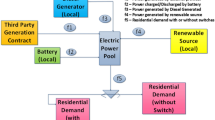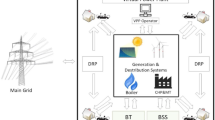Abstract
Operations and maintenance management for renewable energy (RE) projects has become increasingly important in improving energy system models’ precision. Specifically, some elements are uncertain and difficult to predict, such as temperature conditions or system reliability, and these result in more complicated RE projects. Suitable maintenance and insurance policies are vital to reduce risks for RE system operators. This paper formulates a profit model that integrates system reliability, predictive maintenance, and green insurance into electricity pricing and capacity problems. A non-linear optimization solution procedure is proposed to determine the optimal electricity price, capacity, investment plan, predictive maintenance budget, and insurance level while maximizing company profit. The theoretical results indicate that RE systems’ increased reliability decreases the insurance level. However, an increase in the insurance level decreases RE project investments. Therefore, companies can attract more investments for RE projects if RE system reliability increases while insurance costs decrease. Additionally, this work not only presents a numerical analysis with examples and a sensitivity analysis to illustrate the model, but also discusses the opportunities this work offers for managers and analysts in practice.








Similar content being viewed by others
References
Abdollahzadeh, H., Atashgar, K., & Abbasi, M. (2016). Multi-objective opportunistic maintenance optimization of a wind farm considering limited number of maintenance groups. Renewable Energy, 88, 247–261. https://doi.org/10.1016/j.renene.2015.11.022
Aki, H., Oyama, T., & Tsuji, K. (2000). Analysis on the energy pricing and its reduction effect on environmental impact in urban area including DHC. In Paper presented at the 2000 IEEE Power Engineering Society Winter Meeting. Conference Proceedings (Cat. No.00CH37077).
Babonneau, F., & Haurie, A. (2019). Energy technology environment model with smart grid and robust nodal electricity prices. Annals of Operations Research. https://doi.org/10.1007/s10479-018-2920-1
Billimoria, F., & Poudineh, R. (2019). Market design for resource adequacy: A reliability insurance overlay on energy-only electricity markets. Utilities Policy, 60, 100935. https://doi.org/10.1016/j.jup.2019.100935
Bjarne, S., Martin, B., Paul, T., & Tobias, S. S. (2020). Experience curves for operations and maintenance costs of renewable energy technologies. Joule, 4, 1–17. https://doi.org/10.1016/j.joule.2019.11.012
Celebi, E., & Fuller, J. D. (2012). Time-of-use pricing in electricity markets under different market structures. IEEE Transactions on Power Systems, 27(3), 1170–1181. https://doi.org/10.1109/TPWRS.2011.2180935
Chao, H.-P. (2010). Price-responsive demand management for a smart grid world. The Electricity Journal, 23(1), 7–20. https://doi.org/10.1016/j.tej.2009.12.007
Ding, F., & Tian, Z. (2012). Opportunistic maintenance for wind farms considering multi-level imperfect maintenance thresholds. Renewable Energy, 45, 175–182. https://doi.org/10.1016/j.renene.2012.02.030
Erguido, A., Crespo Márquez, A., Castellano, E., & Gómez Fernández, J. F. (2017). A dynamic opportunistic maintenance model to maximize energy-based availability while reducing the life cycle cost of wind farms. Renewable Energy, 114, 843–856. https://doi.org/10.1016/j.renene.2017.07.017
Fernandes, G., Gomes, L., Vasconcelos, G., & Brandão, L. (2016). Mitigating wind exposure with zero-cost collar insurance. Renewable Energy, 99, 336–346. https://doi.org/10.1016/j.renene.2016.07.016
Filho, J. C. R., Affonso, C. M., & Oliveira, R. C. L. (2009). Pricing analysis in the Brazilian energy market: A decision tree approach. In Paper presented at the 2009 IEEE Bucharest PowerTech.
Flores-Colen, I., & de Brito, J. (2010). A systematic approach for maintenance budgeting of buildings façades based on predictive and preventive strategies. Construction and Building Materials, 24(9), 1718–1729. https://doi.org/10.1016/j.conbuildmat.2010.02.017
Glower, J. S., & Enz, J. (1996). Pricing the variance of wind energy. In Paper presented at the Proceedings of the 39th Midwest Symposium on Circuits and Systems.
Gürhan Kök, A., Kevin, S., & Yücel, Ş. (2016). Impact of electricity pricing policies on renewable energy investments and carbon emissions. Management Science. https://doi.org/10.1287/mnsc.2016.2576
Han, X., Zhang, G., Xie, Y., Yin, J., Zhou, H., Yang, Y., & Bai, W. (2019). Weather index insurance for wind energy. Global Energy Interconnection, 2(6), 541–548. https://doi.org/10.1016/j.gloei.2020.01.008
IRENA (2019). Renewable energy power generation costs in 2018. InternationalRenewable Energy Agency.
Iskin, I., Daim, T., Kayakutlu, G., & Altuntas, M. (2012). Exploring renewable energy pricing with analytic network process—Comparing a developed and a developing economy. Energy Economics, 34(4), 882–891. https://doi.org/10.1016/j.eneco.2012.04.005
Jin, X., Zhang, Z., Shi, X., & Ju, W. (2014). A review on wind power industry and corresponding insurance market in China: Current status and challenges. Renewable and Sustainable Energy Reviews, 38, 1069–1082. https://doi.org/10.1016/j.rser.2014.07.048
Khare, V., Nema, S., & Baredar, P. (2019). Reliability analysis of hybrid renewable energy system by fault tree analysis. Energy & Environment. https://doi.org/10.1177/0958305X18802765
Kian, A., & Keyhani, A. (2001). Stochastic price modeling of electricity in deregulated energy markets. In Paper presented at the Proceedings of the 34th Annual Hawaii International Conference on System Sciences.
Li, J. (2013). China wind power report 2013. China Environmental Science Press.
Lin, Y. K., & Chang, P. C. (2012). System reliability of a manufacturing network with reworking action and different failure rates. International Journal of Production Research, 50(23), 6930–6944. https://doi.org/10.1080/00207543.2011.638939
Lin, Y.-K., Huang, C. F., & Chang, P. C. (2013). System reliability evaluation of a touch panel manufacturing system with defect rate and reworking. Reliability Engineering & System Safety, 118, 51–60. https://doi.org/10.1016/j.ress.2013.04.007
Liu, Y. W., Li, L. L., Tseng, M. L., Lim, M. K., & Helmi Ali, M. (2022). Optimal scheduling of combined cooling, heating, and power microgrid based on a hybrid gray wolf optimizer. Journal of Industrial and Production Engineering, 39(4), 277–292. https://doi.org/10.1080/21681015.2021.1974963
Malliaris, M. E., & Malliaris, S. G. (2005). Forecasting energy product prices. In Paper presented at the Proceedings. 2005 IEEE International Joint Conference on Neural Networks
Mérigaud, A., & Ringwood, J. V. (2016). Condition-based maintenance methods for marine renewable energy. Renewable and Sustainable Energy Reviews, 66, 53–78. https://doi.org/10.1016/j.rser.2016.07.071
Mishra, M. N., & Mishra, S. B. (2008). Insurance principles and practices. New Dehli: S. Chang Limited.
Nie, P. Y., Chen, Y. H., Yang, Y. C., & Wang, X. H. (2016). Subsidies in carbon finance for promoting renewable energy development. Journal of Cleaner Production, 139, 677–684. https://doi.org/10.1016/j.jclepro.2016.08.083
Olivencia Polo, F. A., Ferrero Bermejo, J., Gómez Fernández, J. F., & Crespo Márquez, A. (2015). Failure mode prediction and energy forecasting of PV plants to assist dynamic maintenance tasks by ANN based models. Renewable Energy, 81, 227–238. https://doi.org/10.1016/j.renene.2015.03.023
Pecoraro, G., Favuzza, S., Ippolito, M. G., Galioto, G., Sanseverino, E. R., Telaretti, E., & Zizzo, G. (2015). Optimal pricing strategies in real-time electricity pricing environments: An Italian case study. In Paper presented at the 2015 International Conference on Clean Electrical Power (ICCEP).
Rubin, O. D., & Babcock, B. A. (2013). The impact of expansion of wind power capacity and pricing methods on the efficiency of deregulated electricity markets. Energy, 59, 676–688. https://doi.org/10.1016/j.energy.2013.07.020
Shayesteh, E., Yu, J., & Hilber, P. (2018). Maintenance optimization of power systems with renewable energy sources integrated. Energy, 149, 577–586. https://doi.org/10.1016/j.energy.2018.02.066
Tian, Z., Jin, T., Wu, B., & Ding, F. (2011). Condition based maintenance optimization for wind power generation systems under continuous monitoring. Renewable Energy, 36(5), 1502–1509. https://doi.org/10.1016/j.renene.2010.10.028
TPC Taiwan Power Company (2019) Taiwan Power Company rate schedule. https://www.taipower.com.tw/en/page.aspx?mid=317 (Accessed 2020)
Tsao, Y.-C., & Vu, T.-L. (2019). Power supply chain network design problem for smart grid considering differential pricing and buy-back policies. Energy Economics, 81, 493–502. https://doi.org/10.1016/j.eneco.2019.04.022
Wang, C., Nie, P.-Y., Peng, D.-H., & Li, Z.-H. (2017). Green insurance subsidy for promoting clean production innovation. Journal of Cleaner Production, 148, 111–117. https://doi.org/10.1016/j.jclepro.2017.01.145
WBG World Bank Group (2019). State and Trends of Carbon Pricing 2019. Washington, DC: World Bank. © World Bank. https://openknowledge.worldbank.org/handle/10986/31755 License: CC BY 3.0 IGO”.
Wenzhi, S., Zhang, H., Tseng, M. L., Weipeng, Z., & Xinyang, L. (2022). Hierarchical energy optimization management of active distribution network with multi-microgrid system. Journal of Industrial and Production Engineering, 39(3), 210–229. https://doi.org/10.1080/21681015.2021.1972478
Wiggelinkhuizen, E. J. Verbruggen, T. W. Braam, H. Rademakers, L. Xiang, J.. Watson, S Giebel, G. Norton, E. Tiplucia, M. C. MacLean, A. Christensen, A. J. Becker, E. & Scheffler, D. CONMOW: Condition monitoring for offshore wind farms, European Wind Energy Conference and Exhibition, Milan, Italy, 2007.
Yang, H., Qiu, J., Meng, K., Zhao, J. H., Dong, Z. Y., & Lai, M. (2016). Insurance strategy for mitigating power system operational risk introduced by wind power forecasting uncertainty. Renewable Energy, 89, 606–615. https://doi.org/10.1016/j.renene.2015.12.007
Zhang, C., Gao, W., Guo, S., Li, Y., & Yang, T. (2017). Opportunistic maintenance for wind turbines considering imperfect, reliability-based maintenance. Renewable Energy, 103, 606–612. https://doi.org/10.1016/j.renene.2016.10.072
Zhang, C., Gao, W., Yang, T., & Guo, S. (2019). Opportunistic maintenance strategy for wind turbines considering weather conditions and spare parts inventory management. Renewable Energy, 133, 703–711. https://doi.org/10.1016/j.renene.2018.10.076
Funding
Funding was provided by Ministry of Science and Technology, Taiwan (Grant No. 111-2636-E-011-004); Yu-Chung Tsao, National Taiwan University of Science and Technology (Grant No. NTUST- DROXO TECH- No. 10050), Yu-Chung Tsao.
Author information
Authors and Affiliations
Corresponding author
Additional information
Publisher's Note
Springer Nature remains neutral with regard to jurisdictional claims in published maps and institutional affiliations.
Appendix
Appendix
Proposition 1
We set out to establish the KKT conditions for the power company’s constrained maximization problem for renewable energy system. We begin with the Lagrangian of \(E(\prod_{t} )\) for time t as
where \(\mu_{t}^{1}\) and \(\mu_{t}^{2}\) is the Lagrange multipliers. Note that we don’t consider electricity storage, thus the decision at time t are independent with the one at time t + 1. We have the first-order necessary conditions (KKT) nonlinear optimization:
where \(P_{t} \ge 0,K_{t} \ge 0,L_{t} \ge 0,M_{t} \ge 0,\tau_{t} \ge 0,\mu_{t}^{1} \ge 0,\mu_{t}^{2} \ge 0\) and with \(R_{t}^{M} = \Pr \;(K_{t}^{\alpha } L_{t}^{\beta } > D_{t} ) + be^{{\gamma M_{t} }}\) and \(\mu_{t}^{1}\) and \(\mu_{t}^{2}\) are the Lagrange multipliers. The resulting systems are solved to find the optimal values, from which the proposition follows. The KKT necessary conditions are sufficient to guarantee a global maximum policy for the company.
Rights and permissions
Springer Nature or its licensor (e.g. a society or other partner) holds exclusive rights to this article under a publishing agreement with the author(s) or other rightsholder(s); author self-archiving of the accepted manuscript version of this article is solely governed by the terms of such publishing agreement and applicable law.
About this article
Cite this article
Tsao, YC., Vu, TL. Electricity pricing, capacity, and predictive maintenance considering reliability. Ann Oper Res 322, 991–1011 (2023). https://doi.org/10.1007/s10479-023-05164-1
Accepted:
Published:
Issue Date:
DOI: https://doi.org/10.1007/s10479-023-05164-1




